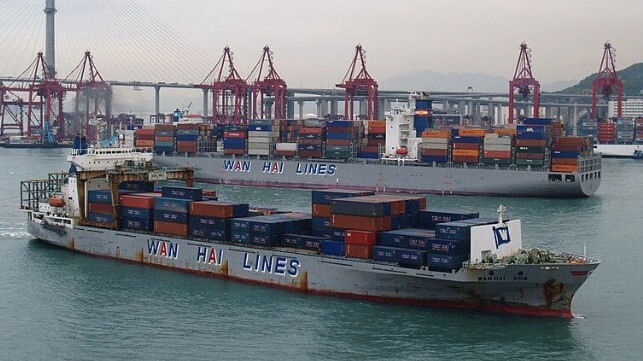Wan Hai Becomes First Carrier to Release Plan to Recycle Old Boxships

After weeks of speculation that falling freight rates and container volumes would lead to a contraction as carriers seek to balance capacity with demand, several of the major analytical services are reporting that several carriers are moving toward rationalizing their fleets. After a period where all available vessels were pushed into service, carriers are now looking to weed out the smallest and least productive ships either by idling ships, and now reports that an increasing number are also being offered for scrap.
Analysts at firms including Drewry and Xeneta had forecast that overcapacity was taking its toll on the market and by the early part of 2023 it was likely that maybe 1.6 million TEU of capacity would be idled as carriers especially on the Pacific sought to reduce capacity. The speculation was that carriers would lay up ships while others point to smaller, niche carriers abandoning service entirely.
Ships on charter were some of the first to feel the downsizing with reports in recent days of several niche carriers retreating. Allseas, which launched as a specialized British carrier, has reportedly been placed under administration. Other companies are also moving to reduce their capacity in the container segment. For example, last week on its quarterly earnings call, U.S. discount retailer Cosco reported it is taking a $93 million charge “mostly related to downsizing our charter shipping activities.” The company in 2021 started by chartering three ships and several thousand containers to help mitigate supply chain challenges and rising shipping costs. They later expanded to a total of seven ships and additional leased containers with commitments made for up to three years. Now with freight rates falling and excess capacity the retailer has decided to reduce its chartered shipping operations.
As these pressures mount, brokers are reporting that a dozen or more smaller containerships have already gone on the market for recycling. They expect additional ships will be offered in the coming weeks.
Taiwan’s Wan Hai Lines became the first of the major carriers to release details on a planned sale of vessels. On December 8, they released a request for bids for the demolition of ten older vessels. The ships identified date from the early to mid-1990s each with a capacity of around 1,000 TEU. The first round of bids are due at the end of this week and then the carrier anticipates creating a short list for a second and final round of bidding. Wan Hai nominated 10 green recycling yards nothing that buyers will have to agree to use supervision and abide by the company’s ESG requirements.
While the current offerings are small, analysts note it could be the beginning of the realignment of the market which is also feeling the pressures of new environmental efforts including the IMO’s 2023 introduction of the Energy Efficiency Existing Ship Index (EEXI) to measure ships’ energy efficiency and to initiate the collection of data for the reporting of their annual operational carbon intensity indicator (CII) and CII rating. Wan Hai, for example, in November marked the delivery of four new 3,000 TEU vessels after two 13,000 TEU vessels in October as part of its fleet modernization efforts saying it was pursuing fleet upgrades to maintain the quality of service to customers.
Clarkson Research in its research note says the sudden availability of ships for recycling is likely a further sign that the carriers recognize the bulb bust in the market. They do not expect an immediate rush of vessels and especially larger ones to market but do think it is a sign for the recyclers that the carriers are beginning open to the idea of rationalizing fleets through demolition.

that matters most
Get the latest maritime news delivered to your inbox daily.
Top photo Wan Hai vessels seen in Hong Kong in 2009 - photo by Pete - CC BY 2.0 license
